| dc.contributor.advisor | C. Forbes Dewey, Jr. | en_US |
| dc.contributor.author | McDougal, Anthony Drew | en_US |
| dc.contributor.other | Massachusetts Institute of Technology. Department of Mechanical Engineering. | en_US |
| dc.coverage.spatial | n-us--- | en_US |
| dc.date.accessioned | 2015-12-03T20:53:44Z | |
| dc.date.available | 2015-12-03T20:53:44Z | |
| dc.date.copyright | 2015 | en_US |
| dc.date.issued | 2015 | en_US |
| dc.identifier.uri | http://hdl.handle.net/1721.1/100105 | |
| dc.description | Thesis: S.M., Massachusetts Institute of Technology, Department of Mechanical Engineering, 2015. | en_US |
| dc.description | Cataloged from PDF version of thesis. | en_US |
| dc.description | Includes bibliographical references (pages 36-40). | en_US |
| dc.description.abstract | Ischemic heart disease remains a leading cause of death globally and in the US. The most common ischemic event is a heart attack, where one or more arteries are obstructed and the cardiac muscle is deprived of oxygen. Although removing the blockage and allowing reperfusion can prevent death, at the same time it can cause significant damage through "reperfusion injury." To date, there are limited methods to predict the viability of the myocardial muscle cell (myocyte) and its quantitative conditions during ischemia. Here, we explore the viability of heart cells using a model for cellular metabolism. We use this model to predict conditions that will sustain viable concentrations of adenosine triphosphate (ATP) and compare these conditions to baseline energy consumption rates. Glycolytic metabolism is modeled using a system of coupled ordinary differential equations that describe the individual metabolic reactions that occur within the cardiac myocyte and its surrounding tissue. Over 200 conditions were simulated to characterize a range of reduced oxygen levels and ATP consumption rates. These conditions were organized according to their steady-state level of [ATP], and reveal a distinct transition region between low levels of ATP that are sustainable and depleted ATP levels that lead to cell death. Our simulations and analysis illustrate how very low concentrations of oxygen in the extracellular tissue allow the cells to perform essential survival functions. The model contains 58 of the molecular species within the cell, so that the conditions of the cell at the time of reperfusion can be predicted. We find the oxygen level required for viability increases roughly linearly with the ATP consumption rate, and is smaller than one would have expected based on previous results. An external tissue level 02 concentration of around 0.007 mM is sufficient to sustain cardiomyocyte viability in the absence of beating. This level of oxygen could be achieved through collateral circulation. This model of ischemia will also provide future investigations of the reperfusion process to proceed from a known metabolic and molecular state of the cardiomyocytes preceding re-oxygenation. | en_US |
| dc.description.statementofresponsibility | by Anthony Drew McDougal. | en_US |
| dc.format.extent | 40 pages | en_US |
| dc.language.iso | eng | en_US |
| dc.publisher | Massachusetts Institute of Technology | en_US |
| dc.rights | M.I.T. theses are protected by copyright. They may be viewed from this source for any purpose, but reproduction or distribution in any format is prohibited without written permission. See provided URL for inquiries about permission. | en_US |
| dc.rights.uri | http://dspace.mit.edu/handle/1721.1/7582 | en_US |
| dc.subject | Mechanical Engineering. | en_US |
| dc.title | Modeling oxygen requirements in ischemic cardiomyocytes | en_US |
| dc.type | Thesis | en_US |
| dc.description.degree | S.M. | en_US |
| dc.contributor.department | Massachusetts Institute of Technology. Department of Mechanical Engineering | |
| dc.identifier.oclc | 929460860 | en_US |
